As Mozart Year comes to a close, a final great paean to the Austrian composer is taking place this week at Theater an Der Wien. World renowned choreographer Anna Teresa de Keersmaeker and her Rosas troupe have brought to Vienna a restaging of her Un moto di gioia, based on the arias of Mozart.
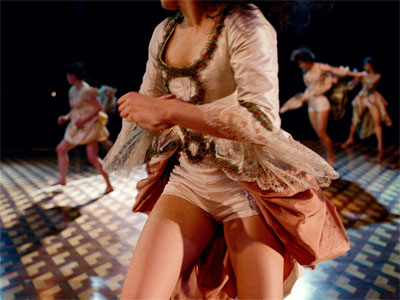
Un-Moto-Di-Gioia
First and foremost, Un moto di gioia is about the music. We face gorgeous and tragic aria after gorgeous and tragic aria. Love, jealousy, fury, passion are all the text to these short lyrics. Fourteen of them.
The way Anna Teresa de Keersmaeker has assembled all these disparate pieces of Mozart is very modern, much like a rock or pop album. Of course the quality of the text and the music is exceptional – this is Mozart – but Un moto di gioia really is a greatest hits album. Think Fleetwood Mac’s Greatest Hits. A greatest hits of arias accompanied by dance is a splendid conceit.
Rather than articulating the development of love, Keersmaeker chose to focus on the desire for love, in its unrealised form.
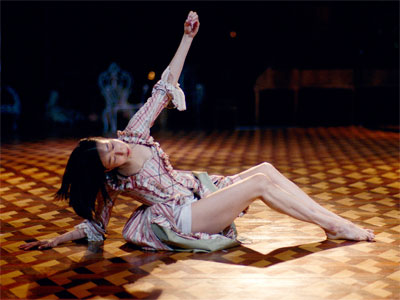
Taka-Shamato
As a musical evening, the Vienna performance are irreproachable and likely the best performances of Un moto di gioia ever. The Vienna Symphoniker was faultless – at least to these ears. They were led by guest conductor Alessandro de Marchi, flamboyant in a blue velvet coat. The orchestra was supported by Claire Chevallier on the piano. Chevallier’s playing was measured and light – a perfect reflection of Mozart’s spirit. The singing was wonderful, it would be difficult to pick a favorite among Patrizia Bicciré, Olga Pasichnyk and Iwona Sobotka. Each was perfectly in tone and resonant, totally at home among the dancers.
As a whole Un moto di gioia ends up a curious hybrid, with the singers so much time on center stage. At various times the dancers threaten to interact with the singers and bring them right into the action. But in the end the dancers leave the singers to their own devices and return to the other dancers, before a real crossover happens and the singer becomes an integral part of the movement.
As a ballet one should say Un moto di gioia is an unqualified success. It is pretty much exactly what Louis XIV had in mind when he developed the ballet in the 18th century: a musical evening with steps, arranged in sequential diversions, supported by costume and decoration.
Anna Teresa de Keersmaeker’s work has always been extraordinarily detailed and aesthetically consistent. Music, dance, costums and stagecraft are all given adequate attention. Here the special circular parquet floor as well as the varied costumes show her attention to detail.
Yet as a dance evening, Un moto di gioia is very complicated, in spite of the fabulous musical assembly. The underlying problem with Un moto di gioia is its unique fixation on unrealised love. Coming fourteen times to the same theme of frustrated and unrealised love is an arduous emotional journey. The human spirit cries out for development in its story telling and there is little change to be had here. Two and a quarter hours of emotional repetition is a long time.
When she created Un moto di gioia, Keersmaeker stated her first concern is with music and movement: “For me, the key question is always the same: ‘Which movements for which music?’ And the hardest part of my task is to find, and then cultivate, the right body language for the work I am tackling.”
On the level of movement and action, Un moto di gioiai never slows down. We see many different scenes, each aria getting its own distinct sketch. Sometimes funny, sometimes tragic, the stageplay never ends.
We begin with women in ballgowns and men in frock coats, Mozartian period pieces. Keersmaeker allows us to slip into a costumed evening of courtly dance before repeatedly subverting the notions of civilisation courtly love. Later a woman comes on stage in leopard skin crawling like a dog. Behind the refinement of clothes, humankind’s animal nature is not far off. This single image demolishes the differences between man and the animal kingdom. In another sequence, the dancers become birds in a mating ritual, the cock preening himself for the hen. Again and again, Keersmaeker suggests we are still part of the animal kingdom, despite the pretty words and fine clothes we wear over our instincts. Love and desire are instinctual attitudes rather than something metaphysical or ethereal.
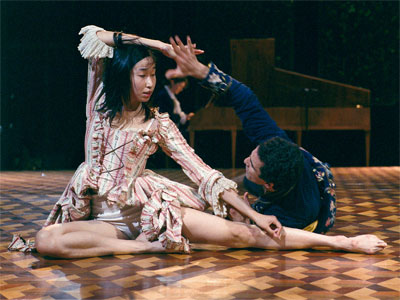
Taka-Shamato-Nordine-Benchorf
Sometime later we get a chorus line of men in semitransparent nightshirts in what appears to be a celebration of lovemaking. Each male dancer finishes the next sketch carrying a grotesque set of Baroque slippers each seeking a woman’s foot to slip fit his slippers. Every man a prince, every woman a Cinderella, implies Keersmaeker very archly.
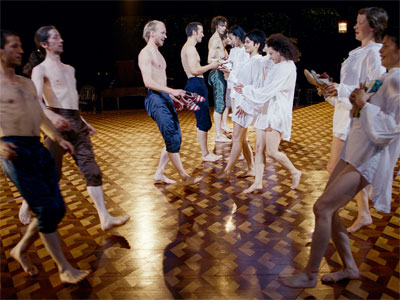
Full-Cast-Un-Moto-Di-Gioia
This was the first Rosas piece with an extensive male cast. One wonders if Keersmaeker knew what to do with them then. For some reason when the men dance mainly they look at the floor rarely at audience. This has the unsettling effect of building a barrier between the audience and the men and leaves our sympathies strongly with the women.
There are strong comic moments in Un moto di gioia. At one point the full female cast lies down in a diagonal line across the stage, each feigning to asleep. Vincent Dunoyer goes from the back of the stage to the front seeking solace in each of their arms. One after another, each of the sleepers push him away and leave the stage. Dunoyer acts first the part of a rejected man but quickly becomes a bawling toddler. Elizaveta Penkóva does his childlike crying voice allowing Dunoyer to unreservedly pantomime without worrying about control of voice. Yet our laughter here is in support of a serious point. It is highly discomfiting to see the border between romantic love and childish egoism erased before one’s eyes.
There is a another fine moment later in the evening when the lights are brought down to an artificial candlight with a ring of small bulbs at stage height. We witness a long slow and repetitive dance which seems to mimic sleeping but in motion.
Un moto di gioia was the first Rosas piece to feature male dancers so prominently. Until this pieces, Rosas was primarily a woman’s company. One can see Keersmaeker’s struggle to integrate the male dancers into her work. The roles are not so outstanding, the movement not so powerful, as what the women have. The characterisation of the male roles is not so subtle.
Of the men, Bostjan Antoncic’s diffident charm and Nordine Benchorf’s earthy intensity leave the strongest impression.

Bruce Campbell-Clinton-Stringer-Vincent-Dunoyer-Igor -Hyshko
As ever with Rosas, all of the women are very good. Both Marta Coronada Ayarra and Elizaveta Penkóva are particularly compelling artists, lighting up the stage with their presence whenever they appeared, quintessential Rosas.
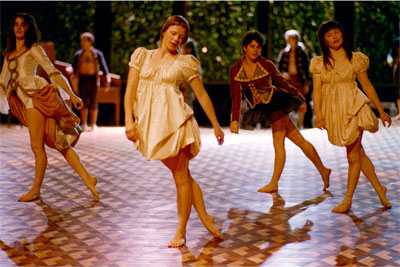
Unidentified-Samantha-Van-Wissen-Marta-Coronado-Ayarra-Fumiyo Ikeda
According to the dancers who performed in one or both of the previous stagings of Un moto di gioia, apparently the ostensible emotional texture has intensified in this latest version. Keersmaeker has encouraged each of them to push further in their expression of emotion and leave irony behind. But irony remains the underlying idiom of Un moto di gioia.
In the program, we are warned that Un morto di gioia is two and one quarter hours without intermission. Yet at one and a half hours the lights went up. This is the first Un morto di gioia was performed with intermission, in a special concession to Vienna audiences. Strange this intermission, for while in the the first hour and a quarter there is some heavy going, in the last twenty minutes before the pause the pace picks up. One is finally just losing oneself in the piece when the intermission comes. The last fifty minutes after the intermission race by like nothing.
Frankly the intermission ends up like some kind of coitus interruptus. Of course it’s fine to start over again and one does (with any luck) reach a satisfactory end, but it’s not quite the same thing. Vienna audiences won’t be denied their sekt and socialising – part of the theatre tradition here. and I hardly feel inclined to fight it – Vienna audiences do come to the theatre, they do talk about theatre, they do care.* And if they want their theatre with intermissions let them have them. But I would have preferred to have gone without.
Un moto di gioia was the first piece Keersmaeker put on the la Monnaie stage – which subsequently became her own to this date. As it was her first opera house piece, perhaps Keersmaeker was excessive in putting her singers in the middle of the stage, building a special floor, endlessly recostuming her dancers. But when a creator hasn’t had those opportunities before and does not know when he or she will get the chance again to enjoy those resources, there is a hunger to take one’s chance, to use everything. One feels that when Keersmaeker staged Un moto di gioia, she did not yet have full control of the large scale opera house medium. Keersmaeker’s later works like Raga for the Rainy Season have much more coherent and stronger dance lines and a far tighter aesthetic. Keersmaeker now takes her time choreographically coming to a single point. Her themes develop slowly and powerfully, the staging does not seem so contrived.
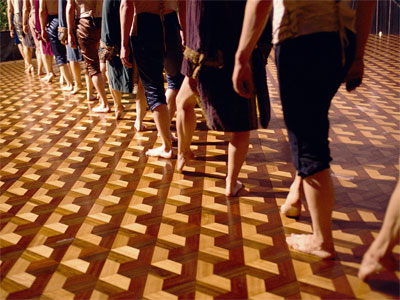
Rosas-Un-Moto-Di-Gioia
Some will find the above too harsh a criticism of a master choreographer. But a surfeit of technique in early work is not unusual for great artists. The dialogue of Shakespeare’s early comedy Love’s Labours Lost is too brilliant – so scintillating that it is difficult for an audience to follow. In his later plays, Shakespeare learned to tame his language to move audiences rather than outwit them. And so it is with Un moto di gioia. Keersmaeker outwits the audience but in the end leaves us holding a bouquet of exquisitely dried roses.
In spite of the emotional limitations of Un moto di gioia, one should not miss the opportunity to see this seminal work live and in such good musical circumstances. We owe a debt of gratitude to Karl Regensburger and Theater an der Wien for arranging this coproduction.** Un moto di gioia is one of the high points of Mozart year in Vienna and a splendid way to send off it off. Many of the other productions in honour of the Mozart celebration seemed contrived or forced. Un moto di gioia is intrinsically Mozartian. No doubt he would take less issue with the irony and detachment of Keersmaeker’s play on his works than does this reviewer.
* I’ll never forget Jan Ritsema’s remarks two years ago at ImPulsTanz about the disgusting bourgeois Vienna audiences for whom it is a shame to perform. What a foolish notion. Ritsema should just be glad that in Vienna people still come to the theater at all after everything he and his ilk done to empty the theatres or force audiences to the cinema instead.
** Thanks to ImPulsTanz (the great summer dance festival founded by Mr. Regensburger’s creation) we’ve seen at least one and sometims as many as three Rosas productions every year for the last ten years. Raga for the Rainy Season is one of the greatest pieces of dance I’ve ever seen, the work of a master at the peak of her powers. It’s wonderful to have the chance to see the historic work. Rosas will be back again this summer in Vienna.

